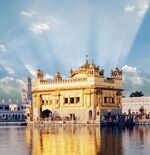| No Title | |
|---|---|
[[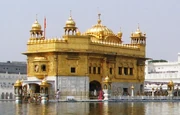 |250px]] |250px]]Golden Temple[1][2] | |
|
No Title |
No information |
| Part of a series on Sikhism |
|
|
|
|
Coordinates: 31°37′12″N 74°52′35″E / 31.620029°N 74.876394°E Golden Temple[1] (Punjabi: ਹਰਿਮੰਦਰ ਸਾਹਿਬ) or Harmandir Sahib[3] (Punjabi: ਦਰਬਾਰ ਸਾਹਿਬ), informally referred to as The Golden Temple or Temple of God,[1] is culturally the most significant place of worship of the Sikhs and one of the oldest Sikh gurdwaras. It is located in the city of Amritsar, which was established by Guru Ram Das Ji, the fourth guru of the Sikhs, and is, also due to the shrine, known as Guru Di Nagri meaning city of the Guru.
Introduction[]
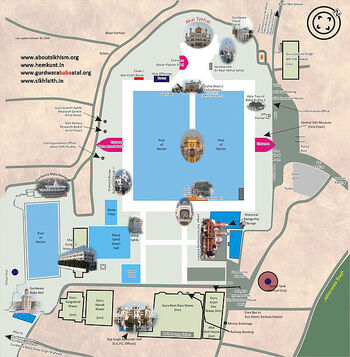
The Harmandir Sahib is considered the holiest shrine by Sikhs. The 11th and eternal Guru Sri Guru Granth Sahib Ji is present inside it. It is moved to the Sri Akal Takhat Sahib at around 10 PM and then moved back from there to Sri Harmandir Sahib at 4.45 AM,[4] site contains the time schedule, please note that there might be changes in the timing as per the season. Its construction was mainly intended as a place of worship for men and women from all walks of life and all religions to come and worship God equally.[1][5] The Sri Guru Granth Sahib is the holiest literature in the Sikh religion,[5] the tenth Guru of Sikhs, Sri Guru Gobind Singh on 7 October 1708 made it the eternal Sikh Guru and the leader of Sikhism.[5] Anywhere in the world where the Guru Granth Sahib is present is equally holy and precious to Sikhs. Harmandir Sahib was built with four doors to show that every religion or faith is allowed to go in to meditate or just listen to the prayers for peace.[6]
History[]
The fourth Guru of Sikhism, Guru Ram Das, excavated a tank in 1577 which subsequently became known as Amritsar (meaning: Pool of the Nectar of Immortality),[3] giving its name to the city that grew around it. In due course, a splendid Sikh edifice, the Harmandir Sahib (Temple of God),[3] was constructed in the middle of this tank which became the supreme centre of Sikhism. Its sanctum came to house the Adi Granth comprising compositions, Sikh values, philosophies and teachings of the Sikh Gurus and other saints of Guru Nanak's time, e.g. Ravidas a Hindu Guru, Baba Farid a Sufi Sant (Saint) and Kabir, all of whom the Sikhs refer to as the Bhagats.
The compilation of the Adi Granth was started by the fifth Guru of the Sikhs, Guru Arjun Dev.
The Amritsar area[]
Amritsar is located in the Majha region of the Punjab. Majha is also known as the Bari Doab, since it is the Doab (Do = two, ab = rivers) or the (fluvial) tract of land which lies between two of the five great rivers of the province, the Ravi and the Beas. As such, Majha lies in the heart of the ancient Punjab region, comprising Gurdaspur, Batala and Tarn Taran Sahib as well as Amritsar. Amritsar is also known as "Sifti Da Ghar" or Adorable Abode.
Construction of the Harmandir Sahib[]
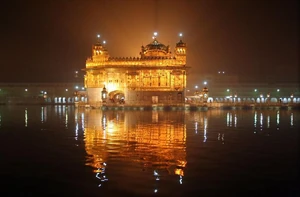
Harmandir Sahib at night
Originally built during AD 1574, the site of the temple was surrounded by a small lake in a thin forest. The third of the six grand Mughals, emperor Akbar, who visited the third Sikh Guru, Guru Amar Das, at the neighbouring town of Goindval was so impressed by the way of life in the town that he gave a jagir (the land and the revenues of several villages in the vicinity) to the Guru's daughter Bhani as a gift on her marriage to Bhai Jetha, who later became the fourth Sikh Guru, Guru Ram Das. Guru Ram Das enlarged the lake and built a small township around it. The town was named after Guru Ram Das as "Guru Ka Chak", "Chak Ram Das" or "Ram Das Pura".
During the leadership of the fifth Guru, Guru Arjan Dev Ji (1581-1606), the full-fledged Temple was built. In December 1588 the great Muslim Sufi saint of Lahore, Hazrat Mian Mir, a close friend of Guru Arjan Dev Ji, was asked to lay the corner stone (December 1588).[1][7] The story has been told that a mason then straightened the stone, to which Guru Arjan said, as you have just undone the work of such a holy man, who knows what disaster might come to the Harmandir Sahib.
This story has been used to offer a reason why the temple has been attacked so many times by the Afghans and Mughals and even Inspected by force by Indian Army in 1984, during Operation Bluestar, which laid the foundation stone of Khalistan, the proposed rebellious Sikh Homeland.
The temple was completed in 1604. Guru Arjan Dev Ji, installed the Adi Granth in it and appointed Baba Buddha Ji as the first Granthi (Reader) of the temple on August 1604. In the mid-18th century it was attacked by one of Ahmed Shah Abdali's generals, Jahan Khan, and his Afghan military forces, and had to be substantially rebuilt in the 1760s. However, in response a Sikh Army was sent to hunt down the Afghan force. Both forces met each other 5 miles outside Amritsar where Jahan Khan's army was defeated, and Jahan Khan himself is believed to have been killed by Sardar Dayal Singh.[8][9][10]
The Harmandir Sahib Complex and areas in its vicinity[]
The temple is surrounded by a large Sarovar (manmade lake), known as the AmritSar (Lake of Holy Water or Immortal Nectar). There are entrances to the temple on all four sides, signifying the importance of acceptance and openness; ostensibly, this concept is reminiscent of the tent of Abraham in the Old Testament—his tent was open on all four sides in order to be able to welcome travelers from all directions. Inside the temple complex there are many shrines to past Sikh Gurus, Saints and martyrs (see map). There are three holy trees (Bers) each associated with a historical event or Sikh saint. Inside the temple there are many memorial plaques that commemorate past Sikh historical events, saints, martyrs and includes commemorative inscriptions of all the Sikh soldiers who died fighting in the two World Wars. For a new visitor the first recommended place to visit is the information Office highlighted (4) on the map and followed by visiting the Sikh Central museum near the main entrance called the Ghanta Ghar Deori (clock tower gate). Anyone who wants to enter the Harmandir Sahib may do so, irrespective of religion, colour, creed or sex. The only restrictions are that the person must not drink alcohol, eat meat or smoke cigarettes or use other non prescription drugs while in the shrine. Visitors are, as well, expected to dress appropriately and everyone must cover their heads as a sign of respect, remove their shoes and socks and enter the temple barefooted. Visitors must wash their feet in the small pool of water as they enter the Harmandir Sahib premises. Head scarves are provided.
In 1988, after Operation Black Thunder, a narrow peripheral strip of land (including buildings) was acquired by the government essentially to create a security belt. A large number of people were displaced in the process. However, the project met with a strong resistance from the moderate as well as militant Sikh organisations and the project had to be abandoned, after a senior Government engineer, connected with the project, was killed. The project was revived only in 1993 by the Deputy Commissioner Karan Bir Singh Sidhu, who was also appointed as the Project Director of what was popularly described as the Galliara Project. He changed the concept of the periphery from that of a security belt to that of a second parikarma and created a serene landscape that was fully consistent with the ethereal beauty of the Harmandir Sahib. This was done in quiet consultation with the SGPC. The pilgrims today can travel by foot in the Galliara, where no vehicles are permitted.
Artwork and monument sculptures[]
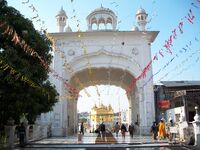
The Langar Deori or East Entrance gate near Ath-sath Tirath (68 Sacred Places), (Point 8) on the map and the Langar Hall (Point 18)
The golden plates which cover the exterior of the Gurdwara's upper floor and domes, as well as its exquisite marblework was done under the patronage of Maharaja Ranjit Singh the leader of the Sikh Empire of the Punjab. Also called Sher-e-Punjab (Lion of the Punjab), the Maharaja was a heavy donor of wealth and materials for the shrine and is remembered with much affection by the Punjabi people in general and the Sikh community in particular. The gold and exquiste marblework originally decorated the many Mughal buildings and monuments in the then Punjab capital of Lahore, many Mughal buildings were stripped of these precious materials during the Sikh period. Maharaja Ranjit Singh was responsible for a renaissance of many Gurdwaras damaged or destroyed during Mughal rule, including many new Gurdwaras as well. Two of the other most revered temples of the Sikhs were built to honor the memory of Guru Gobind Singh Ji. Maharaja Ranjit Singh's deep love of and respect for the 10th Guru lead to his having both the Takht Sri Patna Sahib (Built at the birth place of Guru Gobind Singh Ji) and the Takht Sri Hazur Sahib (the place where Guru Gobind Singh Ji died).
The arch of the Darshani Deorhi opens onto the causeway which leads to the sanctum sanctorum of the Harmandir Sahib; it is 202 feet (62 m) high and 21 feet (6 m) in width. Facing the arch stands the Akal Takht. Hari Singh Nalwa, the Commander-in-Chief of the Sikh Kingdom, wished to make the Akal Takht resplendent with gold and had donated a part of his wealth for this purpose. He also donated a golden palki for the carriage of the Guru Granth Sahib.[11] None of the existing golden palkis in the Harmandir Sahib date back to the 1830s. It was, in all probability, destroyed during Operation Blue Star.[12] Hukam Singh Chimni also contributed to the embellishments at the Harmandir Sahib.
Celebrations at Harmandir Sahib[]
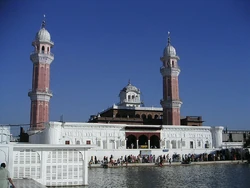
Twin towers (Point 17 on map) of Ramgarhia Bunga
One of the most important festivals is Vaisakhi, which is celebrated in the second week of April (13th usually). Sikhs celebrate the founding of the Khalsa on this day and it is celebrated with fervour in the Harmandir Sahib. Other important Sikh religious days such as the martyrdom day of Guru Teg Bahadur, birthday of Guru Nanak etc., are also celebrated with religious piety. Similarly Diwali is one of the festivals which sees the Harmandir Sahib beautifully illuminated with Divas/Diyas (lamps),lights and fireworks are discharged. During these special wedding occasions 1-2 million pilgrims visit the Holy shrine named Harmandir Sahib.
Most Sikh people visit Amritsar and the Harmandir Sahib at least once during their lifetime, particularly during special occasions such as birthdays, marriage, birth of children, etc.
Operation Blue Star[]

Akal Takht: as it stands today
Between June 3 and June 6, 1984, the Indian Army, under the instruction of Indira Gandhi, moved troops into the Harmandir Sahib to arrest Jarnail Singh Bhindranwale. He and some followers had taken refuge in the Harmandir Sahib, and resisted the police who sought to arrest him on charges of terrorism.[13]
The Harmandir Sahib compound and some of the surrounding houses were fortified. The Statesman reported on July 4 that light machine-guns and sophisticated self-loading rifles were known to have been brought into the compound.
Indira Gandhi ordered the army to launch Operation Blue Star, and fierce fighting ensued between Bhindranwale's supporters and the soldiers. Many of Bhindranwale's supporters were killed along with many soldiers and many visitors to the site who had been kept from leaving the complex once the attack got under way. An official account tallies the deaths of 83 soldiers and 492 civilians.[14] The Harmandir Sahib complex also suffered much damage due to the fighting, especially the holy Sri Akal Takhat Sahib.
Indira Gandhi was reported to have said to General Vaidya during Operation Bluestar "I want Bhindranwale dead." Many Sikhs regarded the attack as a desecration of their holiest shrine. Indira Gandhi was assassinated by two of her bodyguards, both Sikhs, the following October.
In 1986 the repairs performed on the holy Sri Akal Takhat Sahib, which the Rajiv Gandhi Government had undertaken without consultation, were removed. A new Sri Akal Takhat Sahib was completed in 1999 by pilgrims who provided free services and labor.
Related Books[]
See also[]
- Most sacred sites
References[]
- ↑ 1.0 1.1 1.2 1.3 1.4 Harban Singh; Punjabi University (1998). Encyclopedia of Sikhism. Punjabi University. ISBN 817380530X.
- ↑ The Sikhism Home Page: Introduction to Sikhism
- ↑ 3.0 3.1 3.2 Golden Temple, Punjabi University, Parm Barkshish Singh, Devinder Kumar Verma, ISBN 8173805695
- ↑ SGPC
- ↑ 5.0 5.1 5.2 The Sikhism Home Page: Sri Guru Granth Sahib
- ↑ <http://www.slamnet.org.uk/re/sikhism.htm>
- ↑ A Gateway to Sikhism | The Sikh Saints:Mian Mir - A Gateway to Sikhism
- ↑ Volume 2: Evolution of Sikh Confederacies (1708-1769), by Ram Gupta.
- ↑ The encyclopedia of Sikhism (over 1000 entries), by H. S Singha (2000). p.107.
- ↑ The advanced study in history of the Punjab, Volume 1, by G. S. Chhabra (1962). p.411.
- ↑ Sohan Lal Suri. 19th century. Umdat-ut-tawarikh, Daftar III, Part 2, trans. V.S. Suri, (1961) 2002, Amritsar: Guru Nanak Dev University, f. 260
- ↑ Nalwa, V. (2009), Hari Singh Nalwa - Champion of the Khalsaji, New Delhi: Manohar, p. 235, ISBN 8173047855.
- ↑ [1]
- ↑ Varinder Walia, "Army reveals startling facts on Bluestar: Says Longowal surrendered", The Tribune, Chandigarh (March 20, 2007)
Some or all of this article is forked from Wikipedia. The original article was at Harmandir Sahib. The list of authors can be seen in the page history.
External links[]
| Wikimedia Commons has media related to: Harmandir Sahib |
- Gurkirpa.net
- Sikhnet.com
- SacredSites.com
- Sgpc.net
- SriGuruGranthSahib.org
- A journalist’s report on his short tourism experience of Punjabi Sikh shrines
- Amritsar Portal
- Amritsar Paath
- Pictures of the Harmandir Sahib Pictures of the Harmandir Sahib from a backpackers trip around India.
- Some images of Sri Harmandir Sahib
- Golden Temple Photographs
- From Prakash to Sukhasan - Images of Sri Harmandir Sahib
- Video Tour - (Not Professional)
| ||||||||||||||||||||||||||
